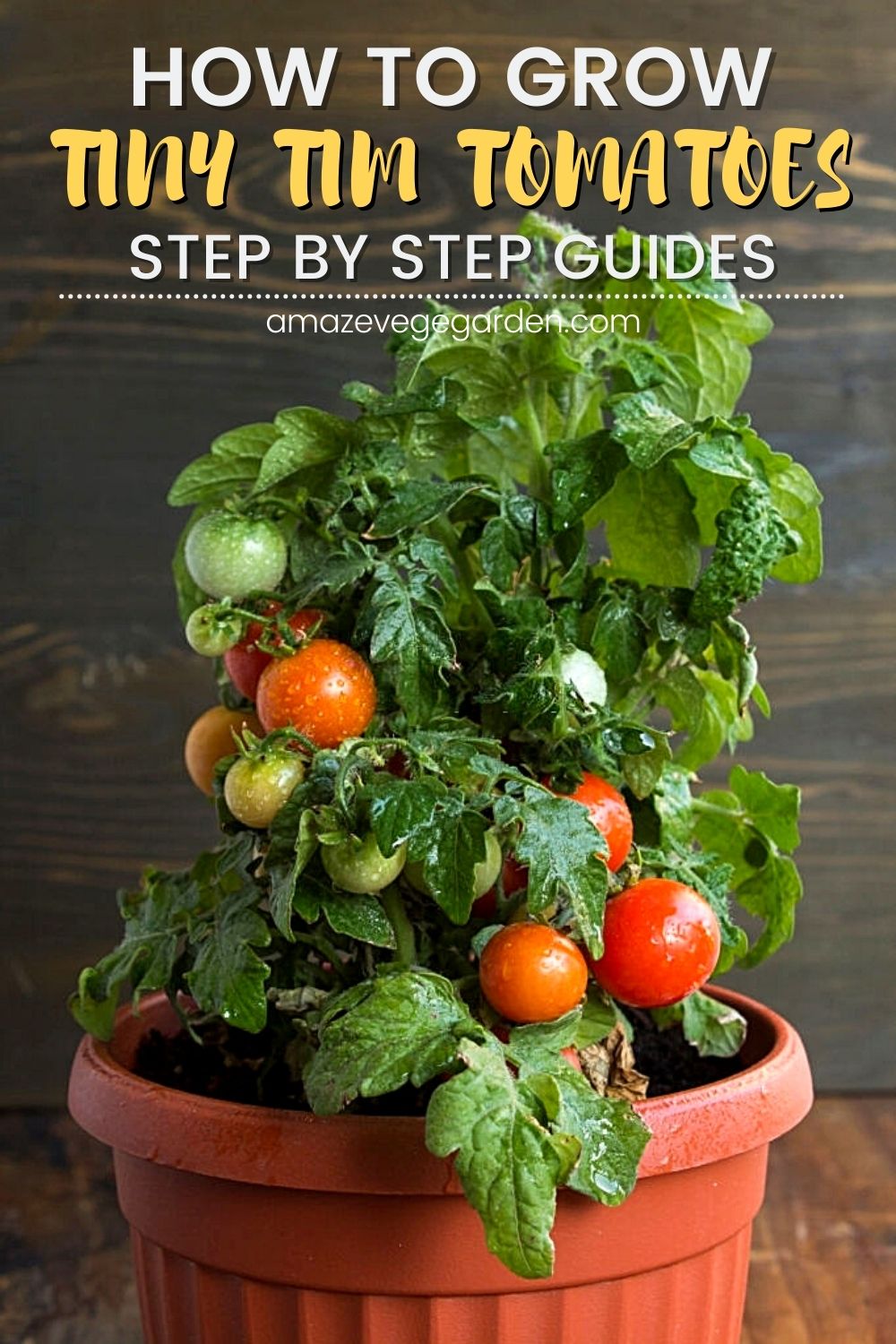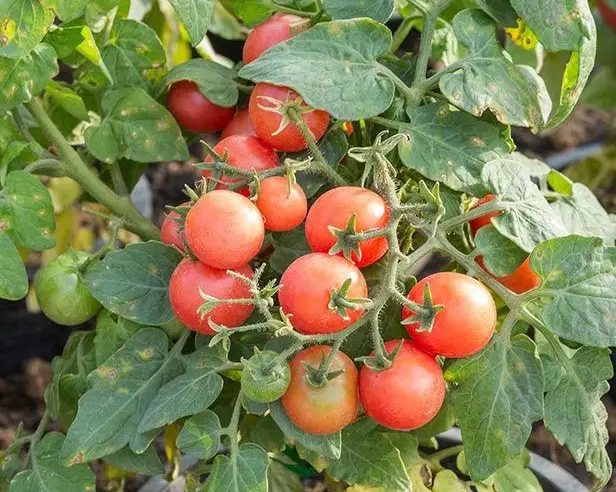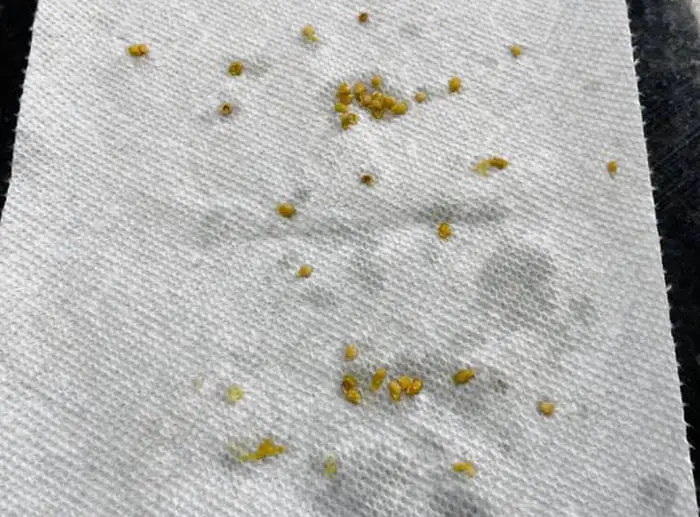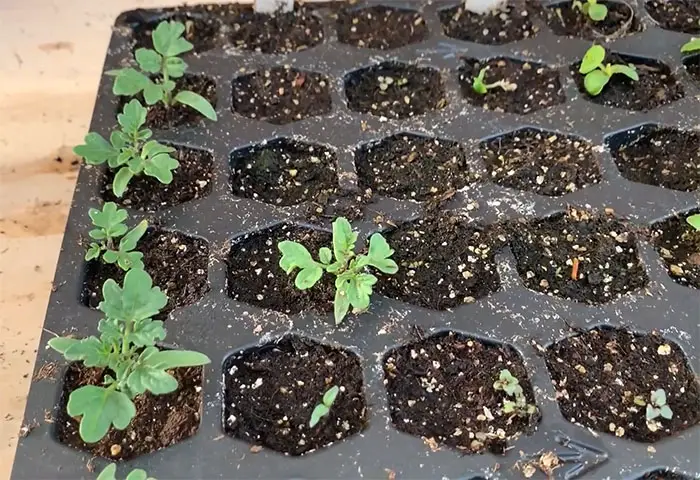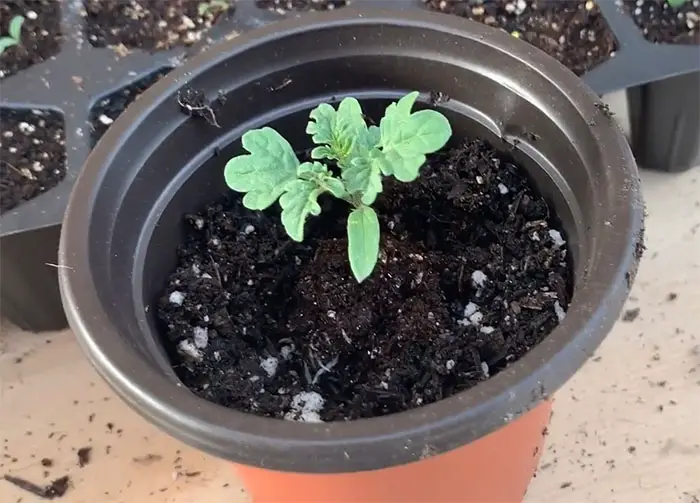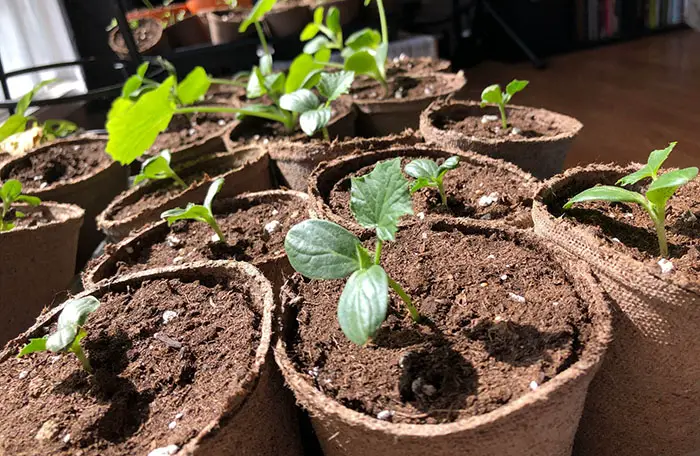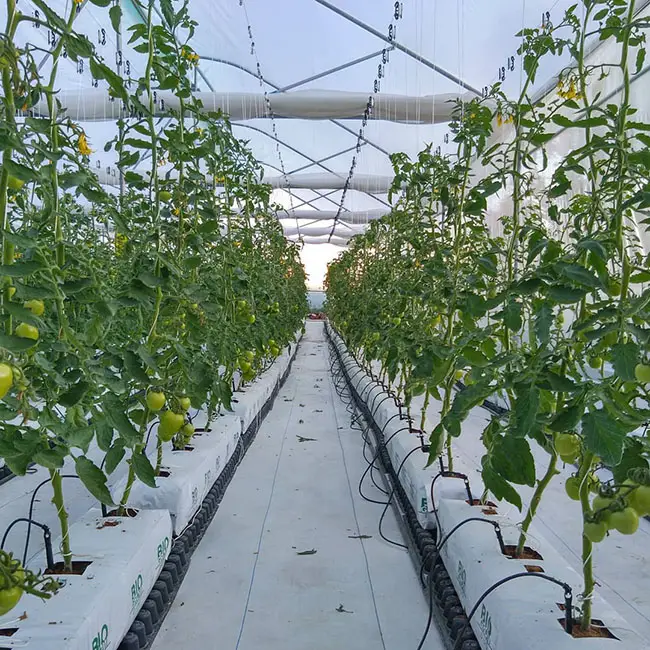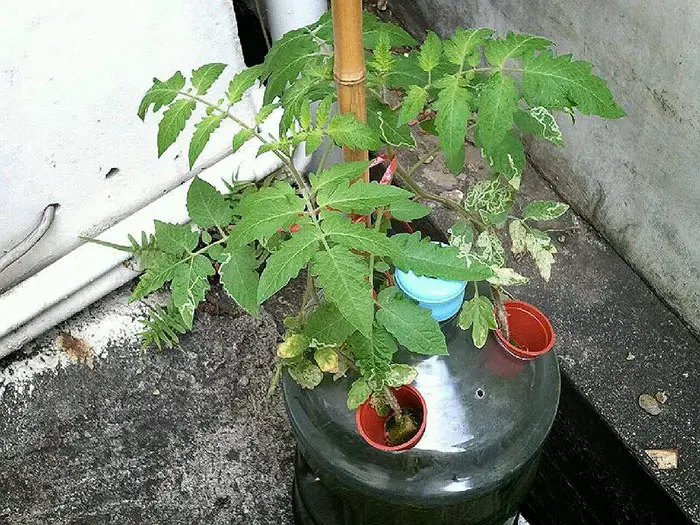Tiny Tim tomato was introduced in 1946. The yield of Tiny Tim tomato is large, and the fruit is small (less than 2cm in diameter). In the case of potted plants, the plant height of this variety is only 20-30 cm, and the crown width is about 30 cm.
Therefore, this variety is tiny in plant shape and fruit, hence “Tiny Tim.” It is suitable to be planted in pots and placed outside. After the fruit is ripe, you can bring it into the house, becoming a unique decoration.
If it is planted in the ground, it will grow about twice as large as growing in pots. The yield will increase as well.
You can plant it at any time within a year, which is very suitable for indoor, small terrace, and balcony vegetable growers. In addition, this variety is also suitable for hydroponics.
Is Tiny Tim Tomato Determinate or Indeterminate?
Tiny Tim tomato is a dwarf and determinate plant. This is because the plant is predetermined by its genetics, where it can just grow to a final height of 12 to 18 inches. Therefore, it is suitable for planting in pots or containers because of its better-behaved growth habits and smaller stature.
Are They Self Pollinating?
Tomato flowers are bisexual, where its flower has both pistils and stamens. It is a self-pollinated plant. The tomatoes grown in the open air are windy or pollinated by bees, so there is no need to worry about pollination. But if your tomatoes are grown on an enclosed balcony, you need to find a way to pollinate.
How To Grow Tiny Tim Tomatoes From Seed?
To grow Tiny Tim tomatoes from seed, first, you will need to get the seeds. You can buy from your local garden store, or you can buy online from Tradewindwsfruit. There are varieties of seeds available there.
Soak the seeds in warm water at 55°C for about 15-20 minutes. During this period, you need to stir the water to heat the seeds evenly constantly.
When stirring, the amount of water should be at least five times the volume of the seeds! When the water temperature reduces to 28°C, keep it at this temperature.
After soaking the tomato seeds for 12-24 hours, take them out and place them in a soaked towel.
You can place them in an ambient that has a temperature between 28°C-30°C and leave them for germination.
Spray water on the towel every day to keep it moist. The seeds will start to germinate after 1-2 days.
You can bury the germinated seeds in the soil, and the seeds will burst out of the soil a few days later and start to grow.
When the seedlings have grown 4-5 leaves, you can start to repot it. If you planted the seeds directly in the pots, you should dig out the roots of the small seedlings and repot them to a larger pot.
If you want to transplant them in your garden, you can also do so. You can prepare the soil according to the ratio of sand and chernozem 1:4 or 1:3, place the plant into the soil, then sprinkler water on the soil.
Planting season
The planting season is in mid-to-late November, while in other places, the planting season can be in mid-to-late December.
Soil selection
Tiny Tim tomatoes are drought-tolerant but are not tolerant to waterlogging. The soil requirements are not too high. To obtain high yields, it is necessary to choose a soil with a deep soil layer. The soil needs to be loose and fertile and strong in water and fertility retention.
Soil Fertilization
After deep plowing and raking, you can open the compartments with a width of 80 cm and a height of 16-24 cm. The grooves of the compartments are 33 cm wide, and each compartment is planted in 2 rows.
When fertilizing, the reasonable ratio of nitrogen, phosphorus, and potassium is 1:1:2. Use 3000-5000 kg of decomposed organic fertilizer per mu, combined with 25 kg of superphosphate and 20 kg of potassium fertilizer (or 80 kg of plant ash).
Pruning
There are two main pruning methods.
- One is to leave only the main stem, and all the side branches are removed (it is appropriate to remove the side branches when they grow to 4-7 cm), which is called single-stem pruning.
- The other is to leave branches beside the main stem. The remaining side branches are all removed, which is called double-stem pruning. Regardless of which pruning method is used, you need to pay attention to tying the vines in time.
Keep flowers and fruits.
To prevent the flowers and fruits from falling, the flowers need to be soaked or painted with 10-20ppm 4-D liquid during the flowering period or sprayed with a 20-30ppm tomato agent.
In the middle and late stages of plant growth, You can appropriately remove the old leaves in the lower part to reduce nutrient consumption and improve ventilation and sunlight transmission.
Fertilization
Appropriate fertilization is required during tomato growth. You shouldn’t only apply nitrogen fertilizers, but you need to apply phosphorus and potassium fertilizers simultaneously.
Generally, fertilizer is applied to promote the growth of stems and leaves. After the first tomato starts to grow, second fertilization should be carried out to promote fruit growth.
Harvest
Tomato ripening will go through 4 stages: green ripening, discoloration, ripening, and perfect ripening.
- For storage and preservation purposes, you can harvest them during the green ripening period.
- You can pick transport and sell during the discoloration period (1/3 of the fruit turns red).
- For sale on the spot or for self-consumption, it should be picked at the ripening stage when more than 1/3 of the fruit turns red.
Harvesting should be done gently, and it is best not to harvest the tomato stalks. This is to prevent the tomatoes from being stabbed by each other stalks during shipment.
If there are still green tomatoes that are not yet ripe, they should be harvested and stored in the greenhouse.
After the tomatoes are ripe, you will put them on the market. This will extend the supply period and increase the economic benefits. You should not use hormones to stimulate tomatoes coloring during the ripening period.
How To Grow Tiny Tim Tomatoes Indoors in Pots
When the Tiny Tim tomato seeds have been sprouted, you can plant them in a container or a pot and keep them indoors if you want to.
2 months ago, I bought a pack of Tiny Time Tomatoes from the supermarket. I then cut out some of them and take out the seeds to grow them. I use a seed tray and fill it with potting mix, and put the seeds in.
It is pretty easy for them to sprout. As long as they get sunlight, water, the right temperature, they will produce seedlings. To let them sprout quicker, you can soak them for up to 24 hours in water.
You need to know that the first shoot from the soil isn’t their true leaf. It would help if you waited for the plant to get a few established leaves before transplanting them into a pot.
Temperature: The adaptable range is 8-35°C, and the most suitable temperature is 18-25°C. If the temperature is below 3°C, you can move the pot into your bedroom or air-conditioned room and put it back on the balcony when the temperature rises.
Sunlight: You can place the pot at your balconies or windowsills where it will get enough sunlight.
Humidity: Potted tomatoes do not require high humidity, so they can be kept in a well-ventilated room.
Moisture: You need to keep your pot at the right moisture level. Do not water too frequently, as excessive moisture will cause root rot. You need to water the plant when the soil in the pot is white or the leaves are wilted. Never water the plant at noon.
Fertilization: Potted Tiny Tim tomatoes do not need to be fertilized before the fruit is grown in the early stage. After you see the fruit, the amount of fertilizer needs to be gradually increased.
Depending on the growth situation, feed the soil with high-potassium compound fertilizer and compost. Such a fertilization method is not only effective but also environmentally friendly and safe. The fertilization cycle is generally about 7 days.
Pruning: Pruning includes single stem, double stem, topping, etc. In addition to the above, You should remove all excess branches and leaves. It would help if you cut off diseased and dead leaves to facilitate ventilation.
If you want to prolong the harvesting, you should reserve 1-2 foot buds within a certain period of time. After the tomatoes on the original pots have been harvested, you will need to cut off the branches, and the next generation is growing. From then on, again and again, to achieve year-round planting.
How To Take Care of Your Tiny Tim Tomatoes
To keep the plant healthy, you need to feed the plants with fertilizer and watering them from time to time. This is to ensure the soil is always remains moist. You can keep a close eye on the plant since Tiny Tim Tomatoes need you to take a lot of care.
Prevention of Pests and Diseases in Potted Tomatoes
It is very little chance for you to get pests and diseases on potted tomatoes. This is due to the dry indoor air humidity. You can also prevent it by spraying the solution that contained water and 0.5% potassium dihydrogen phosphate on the leaves frequently.
You can also spray the solution that contained water and rice vinegar in the ratio of 1:100 every week. This can help to prevent insects and diseases.
If the conditions permit, you can control pests by spraying low-toxic and odorless pesticides every 10 days.
Things to Avoid
You need to avoid giving too much water to the leaves because it can grow fungus on them. To prevent this from happening, make sure your indoor environment is well ventilated. You can keep your window open if you need to.
Water underneath the leaves, especially if you water in the evening. It is because the water made be staying there overnight when the temperature drop. It can turn into mold.
If you notice there is a yellow color on the leaves, it can be a mold problem. The mold may have started developing on the leaves. You can treat it by ensuring good ventilation indoors and avoid any water sitting on the leaves.
If the condition becomes worst, you can remove some of the brown-yellow leaves to prevent the fungus from spreading to other healthy leaves.
How To Grow Tiny Tim Tomatoes in Hydroponic System
Growing hydroponic tomatoes gives you the pleasure to enjoy Tiny Tim tomatoes all year round.
Hydroponics is a method of cultivating tomatoes by providing an environment that is rich with nutrients. As we all know, nutrition, sunlight, temperature, and water are important factors in the growth and health of plants, including tomatoes.
When grown hydroponically, the tomatoes are grown in a controlled environment, like an indoor garden where the appropriate amount of artificial lighting, temperature control, and supplemental nutrition is provided.
More and more people are gearing towards using hydroponics since it provides a wonderful opportunity to eat freshly grown tomatoes throughout the year. Since the plants are not exposed to harsh weather and pests, it also helps get a better yield.
Hydroponic growing systems come with precise instructions and effective types of equipment so that anyone can grow tomatoes in their indoor garden with no hassle.
To start your plants, soak rock-wool cubes in water and place the seeds in them. Then you need to put them in a tray, cover them, and place them in a moist and warm environment till the seedlings begin to sprout.
Once they begin sprouting, the seedlings need to be shifted to where fluorescent lights are used. However, you need to ensure the roots are not exposed to the lights since they may destroy them.
How long does it take to grow Tiny Tim tomatoes hydroponically?
In about 10-14 days, you will notice leaves begin to appear, and the roots will begin to show. This is the time when you’ll need to transplant them in your hydroponic garden. It will take about 2 months to start setting fruit.
The drip irrigation method and the ebb and flow method are the most common methods for cultivating hydroponic tomatoes indoors.
The method you choose depends on you; however, there are certain factors you need to ensure if you want to succeed.
Hydroponic Nutrients for Tiny Tim Tomatoes
Another important factor is the acidity of the nutrient solution. Inadequate levels will lead to toxicity which will destroy the tomato plants.
If you are looking for a complete chemical fertilizer or a 100% organic product, you can try out Advanced Nutrients. They can provide all the nutrition needs for your indoor hydroponic garden.
You can get all the major, minor, and micronutrients for your plants with the hydroponics nutrients Advanced Nutrients provided.
You can also find beneficial bacteria and fungi additives for your hydroponic garden Tarantula Beneficial Bacteria and Piranha Beneficial Fungi by Advanced Nutrients. As the only OMRI-certified beneficial bacteria on the market, Tarantula can and will give you faster growth with bigger yields.
Grow Light: Light is the most important factor, and you should use artificial metal halide light to simulate sunlight. The bulbs should be slowly brought near the plants by an inch or two every few days to introduce higher light levels.
Temperature: It is important to provide tomato plants with a day/night differential temperature. You should adjust the temperature according to daytime or nighttime.
A thermostat can help you here by regulating the temperature, and an exhaust fan will also help you maintain the temperature at the right level and improve air circulation.
Nourishment: Tomato plants need good nourishment; however, when you select a nutritional mix for your plant, make sure it is specially formulated for hydroponic use.
Also, carefully observe any changes that may result from lack of nutrition as it will stunt the growth of the plants and prevent the formation of fruits. Yellow leaves, leaf tips curling up, or red stems are signs that adequate nutrition is not being provided.
Growing hydroponic tomatoes is a great way of getting fresh produce all year round without worrying about weeds, pests, and diseases that are so common when you grow them in the backyard.
All you need is a little bit of knowledge and the right equipment, and you are all set to grow your own fruits under the lights in an indoor environment.
Put a little bit of your own judgment as part of the pleasures and experiences you can get from growing your own fruits and vegetables.
Did you find this post useful? Would you like to get back to it later? Save THIS PIN below to your vegetable or gardening boards on Pinterest! Thanks
